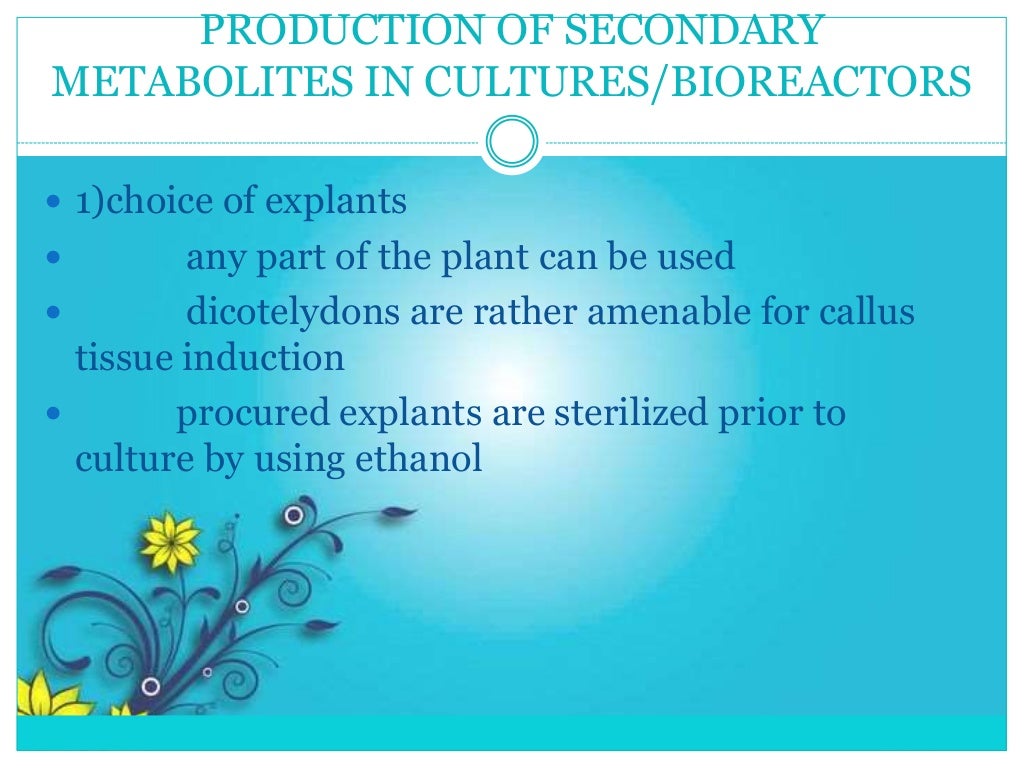Suspension Culture, Cell Culture, Growth Vs Secondary Metabolite Production Presentation
| Introduction to Suspension Culture, Cell Culture, Growth vs Secondary Metabolite Production | ||
|---|---|---|
| Suspension culture refers to the cultivation of cells in a liquid medium, allowing cells to grow as individual entities in a suspended state. Cell culture is the process of growing cells outside of their natural environment, typically in a controlled laboratory setting. The balance between growth and secondary metabolite production is a crucial factor in optimizing cell culture conditions for desired outcomes. |  | |
| 1 | ||
| Advantages of Suspension Culture | ||
|---|---|---|
| Suspension culture allows for easy scalability and high cell density. It provides a homogeneous environment for cells, ensuring uniform nutrient and oxygen distribution. Suspension culture facilitates the collection and separation of cells from the culture medium. | ||
| 2 | ||
| Factors Influencing Growth in Suspension Culture | ||
|---|---|---|
| Nutrient availability and composition directly impact cell growth rates. pH, temperature, and osmolality affect cellular metabolism and growth. Oxygen levels and agitation speed influence oxygen transfer and mass transfer rates, affecting cell growth. | ||
| 3 | ||
| Factors Affecting Secondary Metabolite Production | ||
|---|---|---|
| Differentiation-inducing factors, such as specific nutrients or signaling molecules, can enhance secondary metabolite production. Environmental stressors, such as light or temperature changes, can trigger secondary metabolite synthesis. Genetic modifications or engineering can be employed to enhance secondary metabolite production. | ||
| 4 | ||
| Balancing Growth and Secondary Metabolite Production | ||
|---|---|---|
| Optimizing growth conditions may result in higher cell biomass but lower secondary metabolite production. Limiting nutrient availability or inducing stress conditions can redirect cellular resources towards secondary metabolite synthesis. Fine-tuning culture conditions, such as adjusting nutrient ratios or adding specific inducers, can promote secondary metabolite production without compromising growth. | ||
| 5 | ||
| Strategies for Enhancing Growth in Suspension Culture | ||
|---|---|---|
| Optimizing nutrient composition and availability based on cellular requirements. Controlling environmental factors, such as temperature and pH, to ensure optimal growth conditions. Implementing efficient oxygen transfer methods, such as increasing agitation speed or using oxygen supplementation systems. | ||
| 6 | ||
| Strategies for Enhancing Secondary Metabolite Production | ||
|---|---|---|
| Screening and selecting high-producing cell lines or strains. Genetic engineering to overexpress key enzymes or regulatory genes involved in secondary metabolite biosynthesis. Manipulating culture conditions, such as altering nutrient concentrations or adding specific elicitors, to induce secondary metabolite production. | ||
| 7 | ||
| Monitoring and Analyzing Growth and Secondary Metabolite Production | ||
|---|---|---|
| Monitoring cell growth can be achieved through techniques like cell counting, turbidity measurements, or biomass determination. Analytical techniques such as HPLC, GC-MS, or NMR can quantify and identify secondary metabolites. Transcriptomics, proteomics, and metabolomics can provide insights into cellular pathways and regulatory mechanisms. | ||
| 8 | ||
| Applications of Suspension Culture, Cell Culture, Growth vs Secondary Metabolite Production | ||
|---|---|---|
| Suspension culture is widely used in the production of biopharmaceuticals, vaccines, and recombinant proteins. Secondary metabolites have applications in pharmaceuticals, nutraceuticals, agriculture, and biofuels. Understanding the balance between growth and secondary metabolite production is crucial for optimizing production processes in these fields. | ||
| 9 | ||
| Conclusion | ||
|---|---|---|
| Suspension culture and cell culture provide versatile platforms for studying and producing cells and secondary metabolites. Balancing growth and secondary metabolite production requires careful optimization of culture conditions and genetic engineering approaches. Continuous advancements in biotechnology and process optimization contribute to the development of novel products and therapies. | ||
| 10 | ||
| References (download PPTX file for details) | ||
|---|---|---|
| Smith, R., & Langer, E. (2020). Suspension Cu... Giri, A., & Narasu, M. L. (2000). Production ... Zhu, J., & Shimizu, K. (2003). Regulation sys... |  | |
| 11 | ||





